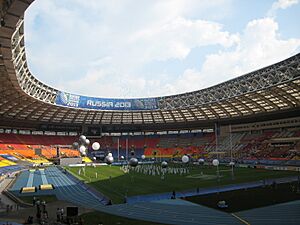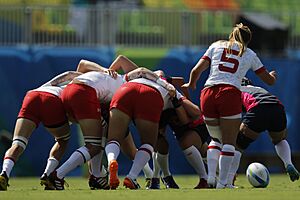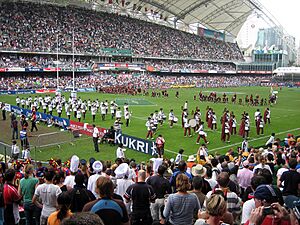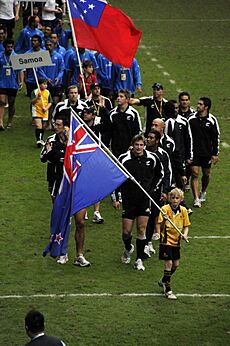Rugby sevens facts for kids

Tom Lucas (in yellow) tries to tackle Samu Bale (in white), who is running with the ball towards the try line.
|
|
| Highest governing body | World Rugby |
|---|---|
| Nicknames | Sevens, 7s, VIIs, Seven-a-side |
| First played | 1883 |
| Characteristics | |
| Contact | Full |
| Team members | 7 |
| Mixed-sex | Separate competitions |
| Type | Outdoor team sport, variant of rugby union |
| Equipment | Rugby ball |
| Presence | |
| Olympic | 2016 onwards |
| World Games | 2001 – 2013 |
Rugby sevens (often called just sevens) is a faster version of rugby union. Instead of 15 players, each team has seven players. Games are much shorter too, with two halves of seven minutes each. Regular rugby union games have 15 players and last 40 minutes per half.
World Rugby manages rugby sevens around the world. This game is popular for both amateur and club teams, especially in the summer. Sevens is played in many places, including parts of Africa, Asia, Europe, the Americas, and especially the South Pacific.
Rugby sevens started in Melrose, Scotland, in the 1880s. The Melrose Sevens tournament is still played every year. The game became even more popular with the Hong Kong Sevens tournament in the 1970s. Later, it was added to the Commonwealth Games in 1998. The yearly World Rugby Sevens Series began in 1999, and the World Rugby Women's Sevens Series started in 2012. In 2016, rugby sevens was played at the Summer Olympics for the first time. It's also part of other big events like the Pan American Games and Asian Games. In 2018, women's rugby sevens was played at the Commonwealth Games for the first time.
Contents
Understanding Rugby Sevens
Rugby sevens follows most of the same rules as the 15-player game. It's played on a field of the same size. But there are some key differences to make the game faster. A normal sevens match has two halves of seven minutes. There's a two-minute break at half-time. Before 2017, finals could be ten minutes per half, but now they are also seven minutes to help prevent injuries.
Even though games are shorter, scores in sevens are often similar to regular rugby. This is because there are fewer defenders, so it's easier to score. The scoring system is the same:
- Five points for a try.
- Three points for a penalty or drop goal.
- Two points for a conversion after a try.
Because matches are short, entire sevens tournaments can be finished in just one day or a weekend. Many tournaments offer different awards like a cup, plate, bowl, and shield. This means more teams can win something, no matter their skill level.
Sevens tournaments are known for being fun and relaxed, often called "festivals." Fans sometimes dress up in fancy dress, and there's entertainment for everyone. The Hong Kong Sevens tournament helped make the game very popular in Asia. Rugby sevens has helped spread the sport around the world, with tournaments in many different countries.
Rules of the Game
Sevens is played on a standard rugby union field. The field is about 100 meters (328 feet) long and 70 meters (230 feet) wide. At each end, there is an H-shaped goal.
How Sevens Rules Are Different
There are a few rule changes in rugby sevens. These changes help make the game quicker and fit the smaller number of players. Here are the main differences:
- Players: 7 players per team on the field (instead of 15).
- Substitutes: Five substitutes are allowed, with five changes during the game.
- Game Length: Seven-minute halves (instead of 40-minute halves).
- Half-time: Maximum of two minutes for half-time (instead of ten minutes).
- Tied Games: If a game is tied, it goes into "golden point" extra time. The first team to score wins.
- Conversions: All conversion attempts must be drop-kicked (you can't place the ball on the ground).
- Conversion Time: Conversions must be taken within 30 seconds of scoring a try.
- Scrums: Only three players from each team form a scrum (instead of eight).
- Kick-offs: In sevens, the team that just scored kicks off. In regular rugby, the team that was scored against kicks off.
- Yellow Cards: A yellow card means a 2-minute suspension for the player (instead of 10 minutes).
- Advantage: Referees make quick decisions on advantage (when a team gains an advantage from an opponent's mistake).
- Officials: In big tournaments, extra officials help judge kicks, so the game doesn't stop.
How the Game Is Played
Player Positions and Team Play
A sevens team has seven players: three forwards and four backs. When a scrum happens, three players from each team join together. The image below shows how a team might set up for a scrum. Three forwards are in the scrum, a scrum-half waits for the ball, and three backs are ready to receive a pass.
|
|
Player numbers in sevens are flexible. Unlike 15-a-side rugby where numbers show positions, in sevens, players are numbered 1 to 12. Any player can wear any number.
In open play, the defending team usually has six players in a line, with one player behind them as a "sweeper." The attacking team uses all seven players against the six defenders. This often means the attacking team tries to move the ball to create an "overload," where they have more players than the defenders in one area. If the defending team makes a tackle and commits players to the ruck, it leaves fewer players in their defensive line. This creates more space for the attacking team to use.
The Fast Pace of Sevens
Rugby sevens is much faster than 15-a-side rugby. Because of this, sevens players are often backs or loose forwards in the 15-player game. The speed difference is most clear during restarts. Scrums in sevens are quicker because only three players form one row. This means fewer restarts and the ball comes out faster. Penalties are usually taken with a quick tap, not a kick for touch. This gets the ball back into play very quickly. When a player is tackled and a ruck forms, the ball also leaves the ruck faster. This is because the attacking team usually only has three players involved: the tackled player, one support player, and the scrum-half.
History of Rugby Sevens
Where It All Began
The idea of playing with fewer players started in Scotland in the 1860s and 1870s. A headmaster named Hely Hutchinson Almond at Loretto School had his students play short games. He wanted them to improve their passing skills. At that time, a full rugby game had 20 players per side, and players often tried to play on their own. Almond believed that if players passed the ball constantly, they could beat any team not used to that tactic.
This idea of teamwork slowly caught on with new clubs. Scotland then shared this idea through Sevens around the world. Teams like New Zealand and South Africa quickly saw how helpful teamwork was.
Scotland's Role
Rugby sevens was first created in 1883 by Ned Haig and David Sanderson. They were butchers from Melrose, Scotland. They wanted to raise money for their local club, Melrose RFC. The very first sevens match was played at The Greenyards, Melrose's home ground, and people loved it. Two years later, Tynedale was the first non-Scottish club to win a Borders Sevens title in 1885.
The popularity of rugby sevens spread from the Borders region throughout Scotland. It became very popular in the 1920s and 1930s. Over 150 sevens tournaments have been held in Scotland since the 19th century. Even today, new tournaments are still being created.
Sevens is still popular in Scotland. The Melrose Sevens tournament brings about 12,000 fans to the small town every year. In 1983, the Melrose Sevens centenary tournament attracted 17,500 fans.
Spreading Around the World
England
England held its first sevens tournament in 1921. This was at Carlisle rugby club, and they beat a Hawick 'B' team in the final. The Percy Park Sevens in North Shields followed in September 1921. Scottish teams were invited to play against local English teams.
The Middlesex Sevens started in 1926. It was set up by Dr J.A. Russell-Cargill, a Scot living in London. The tournament aimed to raise money for King Edward VII Hospital. It raised £1,600, which was a lot of money back then. This became England's most important sevens tournament. It was near London, and 10,000 people came to the second Middlesex tournament.
India
In 1886, a rugby sevens match was played in India. Teams from Dalhousie and Chamba played against each other. The Dalhousie team, who liked rugby, won the match.
New Zealand
Sevens then spread from Scotland to Dunedin, a city in New Zealand with many Scottish people. The first Dunedin Sevens tournament was held on September 28, 1889, to help the Dunedin hospital. From Dunedin, sevens moved north to Christchurch in 1893.
Australia
The first record of a sevens tournament in Australia is from Central Queensland Rugby Union in Rockhampton on July 4, 1891. The Wanderers team won that tournament.
Ireland
The first sevens tournament in Ireland was the Belfast tournament on April 30, 1921. It was held to raise money for the Warriors Day fund.
Argentina
Argentina was the next country to host a sevens tournament, also brought by Scottish people. The Buenos Aires Cricket & Rugby Club held their first sevens event on July 9, 1921. This date is Argentina's Independence Day. The Buenos Aires club won the final.
National Team Tournaments
First International Tournament
The first official tournament for national teams was the 1973 International Seven-A-Side Tournament. It was held at Murrayfield Stadium in Scotland as part of the Scottish Rugby Union's 100-year celebration of rugby.
Hong Kong Sevens
The Hong Kong Sevens tournament started in the 1970s. It was very important in making rugby union more modern. For example, it was one of the first rugby tournaments to get big sponsors, like the airline Cathay Pacific in 1976. It also brought together international teams, which was new for rugby before the first Rugby World Cup in 1987.
World Cup
The Rugby World Cup Sevens, where teams compete for the Melrose Cup, began in 1993.
Growing the Game Around the World
Rugby sevens is still very popular in the Scottish Borders. The ten most important tournaments there form a league called the Kings of the Sevens. Because of Melrose RFC's role in creating rugby sevens, the club and Ned Haig were added to the IRB Hall of Fame in 2008.
Sevens has also become very popular in the Pacific island nations like Fiji, Tonga, and Samoa, and also in Kenya. In many smaller rugby nations, like Poland, rugby sevens is used to introduce people to the sport. It's also popular in places like Hong Kong, Singapore, and Dubai, which are not as strong in the 15-a-side game. Many of the top teams in the World Series are from countries not considered top-tier in 15-a-side rugby.
Major Tournaments
World Rugby Sevens Series
The World Series was a yearly competition that ran from 1999–2000 to 2022–2023. Each season had seven to eleven tournaments from October to June. Most tournaments had 16 teams. Some were "core teams" that played in every event, while others qualified for certain events.
New Zealand has been the strongest team in the Sevens Series, winning 13 of the 23 seasons. This includes the first six seasons in a row. Recently, other teams have also won. Fiji won in 2005–06, 2014–15, and 2015–16. South Africa won in 2008–09 and 2016–17. Samoa won in 2009–10. England and Australia have also finished in the top four many times. In 2015, the United States won their first-ever tournament in the World Series at the 2015 London Sevens.
Famous World Series players include England's Dan Norton, who has scored the most tries (over 230). England's Ben Gollings has scored the most points (2,652).
World Rugby Women's Sevens Series
The Rugby Women's Sevens Series ran from 2012–13 to 2022–2023. Each season had five to six tournaments, usually from November to June. Most tournaments had 12 teams, including "core teams" and some who qualified for specific events.
New Zealand has been the most successful team in this series, winning four of the first six competitions up to 2018.
SVNS Series
In 2023, World Rugby changed the name of the Sevens series to the World Rugby SVNS Series (also known as HSBC SVNS for sponsorship). World Rugby decided to combine the men's and women's tours. They will now happen on the same weekends in the same cities and venues. This started in December 2023 in Dubai and will end in Madrid in June 2024. The goal is to create a festival feeling in each city. Both men's and women's teams will earn the same amount of money. The new format will feature the twelve best men's and women's teams. The top eight teams will compete in a Grand Final weekend to become Series champions. Teams ranked ninth to twelfth will play against the top four teams from a new Challenger Series. This will decide who stays in the top series for the next season.
Summer Olympics
In 2009, the International Olympic Committee voted to include rugby sevens in the 2016 Summer Olympics in Rio de Janeiro, Brazil. Rugby sevens first appeared in an Olympic program at the 2014 Summer Youth Olympics.
In the men's competition at the 2016 Olympics, Fiji won the gold medal. Great Britain took the silver, and South Africa won the bronze. In the women's competition, Australia won the gold medal, New Zealand took silver, and Canada won bronze.
World Cup Sevens

The Rugby World Cup Sevens happens every four years. It is the most important international rugby sevens tournament outside of the Olympic Games. The first tournament was held at Murrayfield Stadium in 1993. England was the first team to win it. Fiji and New Zealand are the most successful teams. Fiji has won two World Cups, and New Zealand has won three. Men's teams compete for the Melrose Cup. The women's competition started in 2009, and teams compete for the Women's Rugby World Cup Sevens Trophy.
Starting with the 2018 event in San Francisco, United States, the World Cup Sevens is held in the middle of the Summer Olympic cycle, two years after each Olympics.
Commonwealth Games
Rugby sevens has been played at every Commonwealth Games since its first appearance in 1998 in Kuala Lumpur, Malaysia. It was the first major international multi-sport event to include the sport. Rugby sevens is now a "Core" sport for the Commonwealth Games Federation. This means it must be played at all future games. The New Zealand men's team has won the gold medal four times. South Africa won the tournament at Glasgow 2014. Women's sevens made its Commonwealth Games debut in the 2018 Games. New Zealand won gold medals in both the men's and women's competitions that year.
Regional Tournaments
Rugby sevens is also played at many regional multi-sport events. These include the Asian Games and the Pacific Games. Rugby union used to be played at the World Games, but this stopped once rugby became an Olympic sport.
Asian Games
Men's rugby sevens was added to the Asian Games in 1998. A women's tournament was added in 2010.
Pan American Games
Men's rugby sevens at the Pan American Games has been held every four years since 2011. Canada, Argentina, and the United States have all won medals. Women's rugby sevens was added to the program for the 2015 Pan American Games.
European Sevens Championship
The Rugby Europe Sevens Grand Prix Series helps teams qualify for other tournaments. The top two teams each year (who are not already core members of the World Rugby Sevens Series) go to the Hong Kong Sevens. This tournament helps teams try to become core teams in the World Rugby Sevens Series. The Europe Grand Prix also helps teams qualify for big events like the Summer Olympics and the Rugby World Cup Sevens.
In Europe, Portugal was very strong in sevens from 2002 to 2010. They only lost the trophy twice, to Russia. In the Grand Prix Series era (from 2011), England and France have won the trophy twice in a row.
Premier Rugby Sevens
Premier Rugby Sevens is a professional rugby sevens league in North America. It started in 2021 and is played at a different time than the World Rugby Sevens Series. This allows top American and international players to take part.
Women's Rugby Sevens
Women's rugby sevens has been mostly dominated by New Zealand. Either the New Zealand team or the Aotearoa Maori Women's Rugby sevens team (playing as New Zealand) won the annual Hong Kong Sevens tournament from 1997 to 2007. The United States won the Hong Kong Sevens in 2008.
The first Women's Rugby World Cup Sevens tournament was held in Dubai in March 2009, at the same time as the men's tournament. Australia beat New Zealand 15–10 in extra-time to become the first to win the Women's Rugby World Cup.
World Rugby (then called the IRB) organized its first official women's sevens tournament outside the World Cup in 2011. This was part of a plan to start a full international series for women's sevens. The series officially launched for the 2012–13 season.
Women's rugby sevens was included in the 2016 Olympic Games because World Rugby successfully pushed to bring rugby back to the Summer Games. Australia won the gold medal, beating New Zealand 24–17 in the final. Canada won the bronze medal. World Rugby also successfully pushed for women's sevens to be included in the 2018 Commonwealth Games.
Many of the Scottish Sevens club tournaments also have events for women's teams.
Sevens vs. Fifteens: Different Paths
As sevens has become very successful, it is starting to become quite different from the 15-player game. Some experts believe that sevens is becoming its own sport. Years ago, players might spend a year or two with a sevens team to improve their running and passing skills. Many famous international players, like Jonah Lomu, improved their game in sevens.
But this is happening less and less. Players now often have to choose if they want to focus on sevens or 15-a-side rugby. The skills and training needed for each game are becoming very different. For example, forwards in 15-a-side rugby need to be big and strong. In sevens, that's not as important. New training methods for sevens players make them very lean, so it's harder for them to switch between the two games.
See also
 In Spanish: Rugby 7 para niños
In Spanish: Rugby 7 para niños
- Tag Rugby







